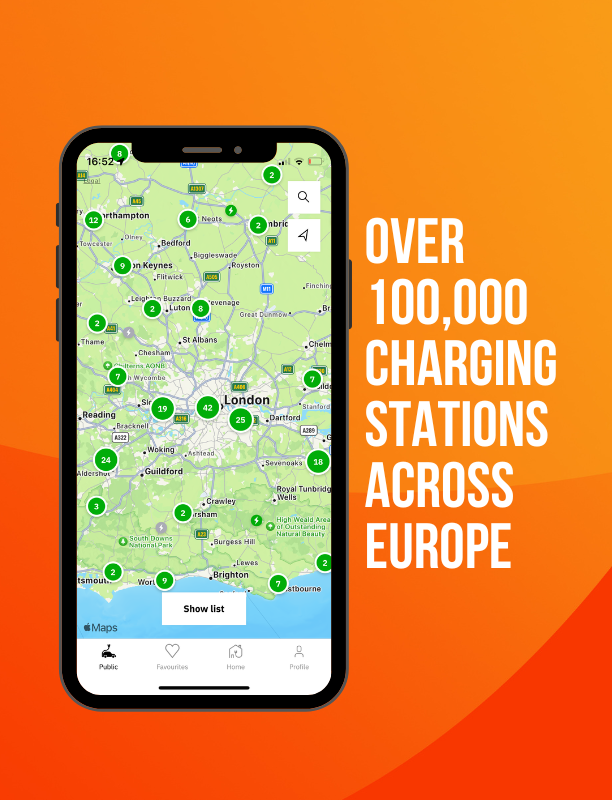Nature Lovers' Paradise - Exploring Croatia's Istrian Peninsula by Electric Vehicle
Experience Europe's most biodiverse peninsula through sustainable electric vehicle adventure. Croatia's Istrian Peninsula offers nature lovers an extraordinary ecosystem journey — from the endemic alpine flora of Učka Nature Park to the pristine marine sanctuaries of Brijuni National Park. With over 1,300 plant species, ancient truffle forests, and Europe's most accessible brown bear habitat, Istria rivals destinations twice its size for wildlife diversity.
Discover why Croatia’s heart-shaped Istrian Peninsula offers Europe’s most biodiverse EV adventure, combining UNESCO World Heritage sites, pristine national parks, and the continent’s finest truffle hunting experiences—all accessible through Croatia’s rapidly expanding charging network.
The Istrian Peninsula, Croatia’s northern jewel, beckons nature enthusiasts with an extraordinary blend of Mediterranean coastlines, pristine mountain forests, and ancient ecosystems that have remained virtually unchanged for centuries. With over 1,300 plant species, 173 bird species, and Europe’s most accessible truffle hunting grounds, this heart-shaped region offers nature lovers an unparalleled sustainable adventure accessible through Croatia’s ambitious EV infrastructure expansion.
But what makes Istria particularly compelling for electric vehicle exploration? Croatia’s recent commitment to installing charging stations every 60 kilometres on all major roads by 2025, coupled with a €200 million investment in EV infrastructure, has transformed this biodiverse peninsula into Europe’s most accessible nature destination for sustainable travellers.
From the towering peaks of Učka Nature Park to the pristine islands of Brijuni National Park, Istria’s protected areas contain more endemic species per square kilometre than any comparable European region—and now they’re all within comfortable EV range of reliable charging infrastructure.
Why Istria Stands Apart for Nature-Loving EV Drivers
Croatia’s Istrian Peninsula occupies a unique position where Mediterranean and Central European ecosystems converge, creating biodiversity hotspots that rival much larger protected areas. The region’s Učka Nature Park alone contains more plant species than entire countries, while the Motovun Forest harbours both black and white truffles—a combination found nowhere else outside Italy’s Piedmont region.
Biodiversity Reality Check: Within a 50-kilometre radius of Pula—Istria’s EV charging hub—nature lovers can experience five distinct ecosystems: coastal wetlands, Mediterranean scrubland, deciduous mountain forests, subalpine meadows, and ancient oak woodlands. This concentration of habitats creates exceptional wildlife viewing opportunities while maintaining practical charging distances for all EV models.
Infrastructure Transformation: Croatia’s charging network features charging locations throughout Istria, with ultra-fast charging capabilities (up to 350kW) at strategic points like Pula Airport and Rovinj Marina. The network’s expansion specifically targets nature destinations, with new installations at Učka Nature Park, Brijuni National Park, and key trailheads throughout the peninsula.
The Ultimate Nature Lover’s EV Route: Complete Ecosystem Discovery
Primary Route: Pula to Učka via Motovun
Distance: 125 kilometres | Driving Time: 2 hours 15 minutes | EV Range Required: 30-35% Ecosystem Coverage: Coastal, Mediterranean forest, truffle woodlands, mountain alpine
This carefully planned route maximises biodiversity encounters while ensuring comfortable charging intervals, taking nature lovers through Croatia’s most pristine ecosystems without range anxiety.
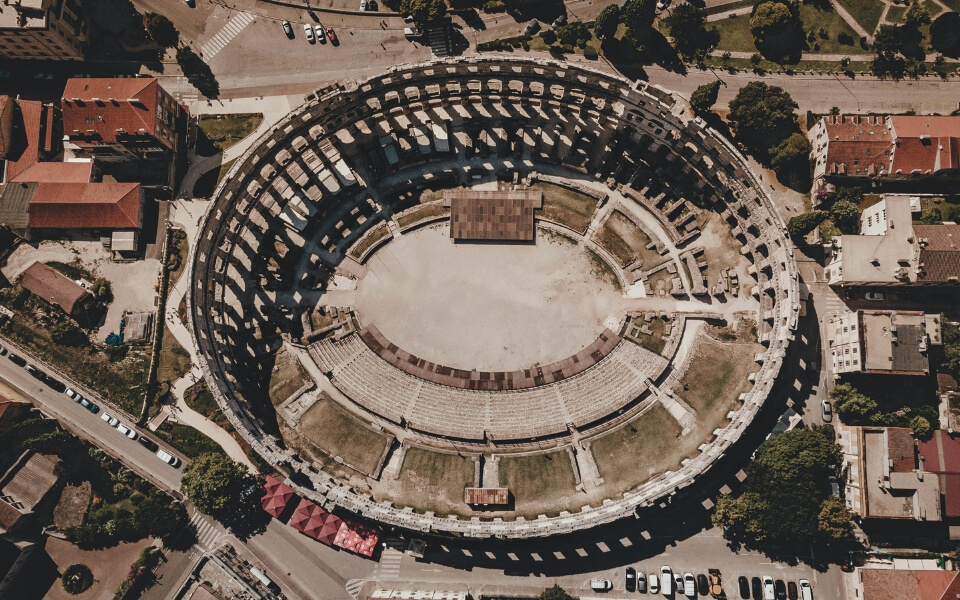 Pula Amphitheatre
Pula Amphitheatre
Starting Point: Pula’s Ancient Amphitheatre and EV Hub
Begin your Istrian nature odyssey at Pula, where Croatia’s largest Roman amphitheatre overlooks one of the peninsula’s most comprehensive EV charging facilities. The ELEN ultra-fast charging station at Pula Airport (10 kilometres from city centre) offers 350kW charging while the nearby Brijuni National Park ferry terminal provides 100kW infrastructure perfectly timed for your first ecosystem exploration.
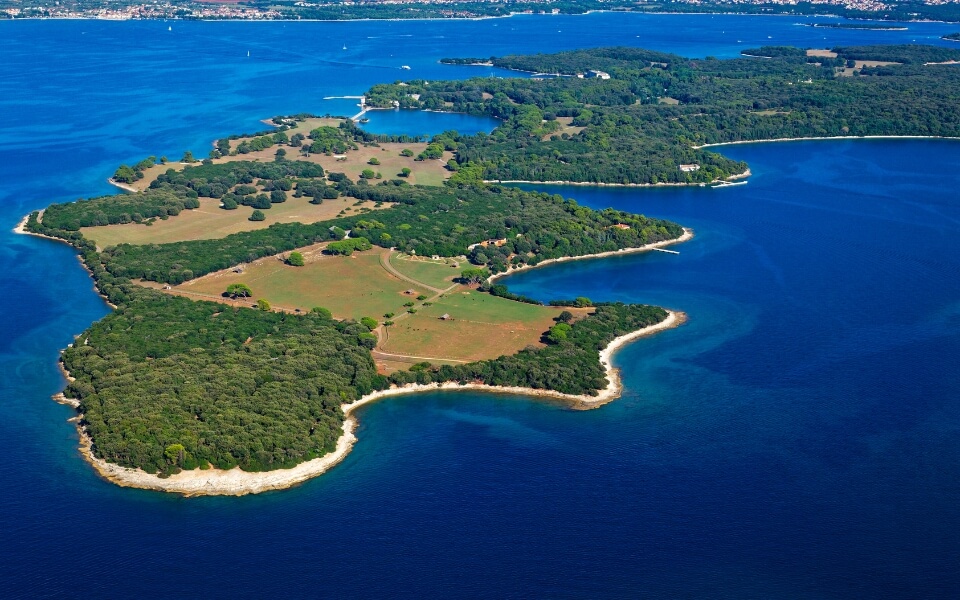 Brijuni National Park
Brijuni National Park
Essential Nature Stop: Brijuni National Park
| Distance from Pula: 15 kilometres | Ferry Access: Fažana | On-island EV Infrastructure: Limited (leave vehicle on mainland) |
Brijuni Islands represent Croatia’s most pristine marine ecosystem, accessible via 15-minute ferry from Fažana. This unique archipelago, once Tito’s private retreat, now serves as a living laboratory where Mediterranean flora and fauna thrive under strict protection. The islands host over 680 plant species and serve as crucial migration stopover points for more than 200 bird species.
Wildlife Highlights for Nature Lovers:
- European Roe Deer: Introduced population now naturalised across the main island
- Peacocks: Descendants of gifts from international leaders, now breeding naturally
- Bottlenose Dolphins: Frequently observed from coastal paths during early morning walks
- Griffon Vultures: Occasional sightings during spring and autumn migrations
- Endemic Orchids: 18 species including the rare Adriatic Lizard Orchid
Practical EV Strategy: Park at the secure Allego charging station in Fažana (€0.35/kWh) while exploring Brijuni. The 3-4 hour island experience allows ample charging time, and the return journey positions you perfectly for inland mountain exploration.
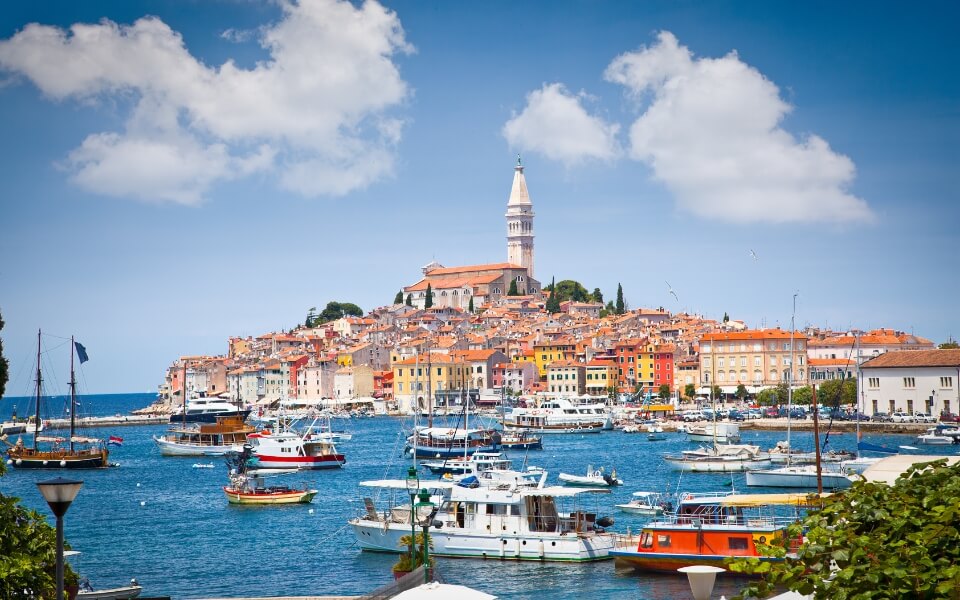 Rovinj Croatia
Rovinj Croatia
Coastal to Mountain Transition: Rovinj to Motovun
| Distance: 45 kilometres | Elevation Gain: 277 metres | Charging: Rovinj Marina to Motovun village centre |
The transition from coastal to inland ecosystems provides nature lovers with Croatia’s most dramatic biological diversity shift within a single EV journey. This route showcases how topographical changes create distinct microclimates supporting entirely different flora and fauna.
Rovinj: Coastal Ecosystem Gateway
Rovinj serves as Istria’s primary coastal charging hub with multiple stations offering rapid charging while you explore the town’s unique position where terrestrial and marine ecosystems intersect. The Rovinj archipelago comprises 22 islands and islets, each supporting distinct endemic plant communities shaped by salt spray, limestone karst, and Mediterranean climate.
Coastal Flora Discoveries:
- Sea Lavender (Limonium cancellatum): Endemic coastal species found only on Istrian limestone cliffs
- Istrian Bellflower (Campanula istriaca): Rare endemic surviving in coastal rock crevices
- Mediterranean Spurge (Euphorbia spinosa): Cushion-forming plant adapted to extreme coastal conditions
- Wild Rosemary (Rosmarinus officinalis): Natural coastal populations predating cultivation
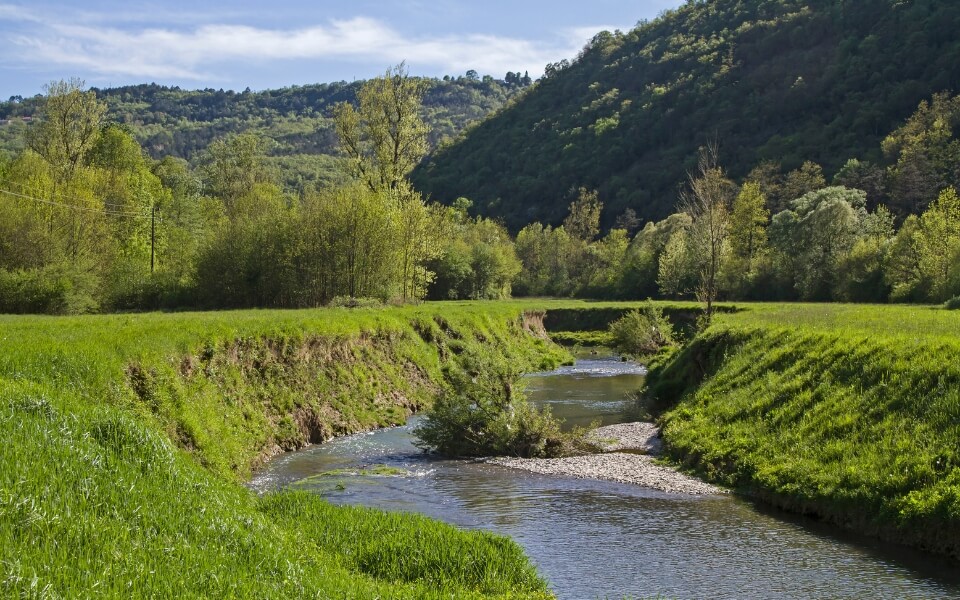 Mirna River Valley
Mirna River Valley
Truffle Territory: Motovun Forest Ecosystem
| Distance from Rovinj: 35 kilometres via B141 | Charging Available: 22kW AC stations in Motovun village |
The Motovun Forest, spanning 900 hectares along the Mirna River Valley, represents Europe’s most accessible truffle ecosystem. This ancient woodland, where Quercus pubescens (Pubescent Oak) and Carpinus betulus (Hornbeam) create the perfect mycorrhizal conditions for both Tuber magnatum (white truffles) and Tuber melanosporum (black truffles) to flourish.
Ecosystem Significance: The Motovun Forest maintains the specific soil pH (7.5-8.5), calcium carbonate content (40-60%), and moisture levels required for premium truffle development. The symbiotic relationship between truffle fungi and tree roots creates a complex underground network supporting numerous other mycorrhizal species, making this one of Europe’s most sophisticated forest floor ecosystems.
Wildlife Endemic to Truffle Forests:
- Wild Boar (Sus scrofa): Natural truffle dispersers whose rooting behaviour aids spore distribution
- European Badger (Meles meles): Nocturnal truffle consumers contributing to forest regeneration
- Istrian Shorthaired Hound: Traditional truffle hunting breed with extraordinary scent capabilities
- Red Squirrel (Sciurus vulgaris): Indicator species for healthy deciduous forest ecosystems
Mountain Majesty: Učka Nature Park’s Alpine Ecosystem
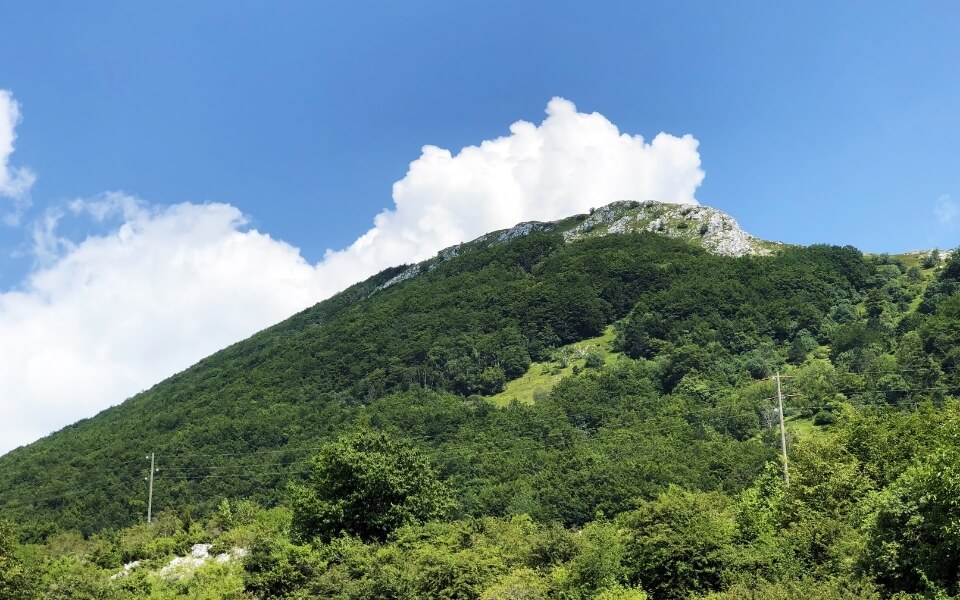 Vojak Peak
Vojak Peak
The Crown Jewel: Vojak Peak and Biodiversity Summit
| Distance from Motovun: 55 kilometres | Elevation: 1,401 metres | Charging: Poklon Mountain Hut (22kW AC) |
Učka Nature Park encompasses 160 square kilometres of the peninsula’s most pristine ecosystems, rising from Mediterranean coastal vegetation to subalpine meadows within a 20-kilometre span. The park’s crown jewel, Vojak Peak at 1,401 metres, offers not just panoramic views spanning from the Italian Alps to the Velebit Mountains, but also access to Istria’s most endangered alpine flora.
Endemic Alpine Flora at Vojak:
- Učka Bellflower (Campanula istriaca): Found only on Učka’s limestone peaks
- Istrian Iris (Iris pseudopallida): Endemic species flowering May-June
- Mountain Avens (Geum montanum): Southernmost population in the Balkans
- Alpine Aster (Aster alpinus): Isolated relict population from ice age
Biodiversity Vertical Zonation: Učka’s unique position creates distinct elevation zones each supporting specific plant communities. The Mediterranean zone (0-400m) features Holm Oak and Strawberry Tree, transitioning through the Submontane zone (400-800m) with Pubescent Oak and Hornbeam, reaching the Montane zone (800-1,401m) where European Beech and endemic alpine species dominate.
Critical Habitat for Endangered Species:
- Brown Bear (Ursus arctos): Occasional visitors from neighbouring Slovenia, with confirmed sightings in 2023-2024
- Lynx (Lynx lynx): Reintroduced population from Slovenia’s forests, with territorial ranges extending into Učka
- Golden Eagle (Aquila chrysaetos): Nesting pairs confirmed on northern cliff faces
- Fire Salamander (Salamandra salamandra): Indicator species for pristine mountain stream ecosystems
Advanced Hiking Trails for Serious Nature Enthusiasts
Vojak Summit Trail via Poklon
| Distance: 3.5 kilometres one-way | Elevation Gain: 400 metres | Duration: 2.5 hours round trip |
| Difficulty: Moderate | Best Months: May-October | EV Charging: Poklon Mountain Hut |
This primary summit approach offers nature lovers the most comprehensive ecosystem traverse, beginning in mixed deciduous forest and culminating in alpine meadows. The well-marked trail features 15 interpretive stations explaining endemic species, geological formations, and ecosystem interdependencies.
Trail Highlights for Nature Photography:
- Kilometre 1.2: Beech Forest Cathedral - Ancient trees forming natural cathedral spaces
- Kilometre 2.1: Karst Dolines - Limestone depressions creating unique microclimates
- Kilometre 3.0: Alpine Meadow Edge - Transition zone supporting rare endemic flowers
- Summit: 360-degree Ecosystem Overview - Visual identification of six distinct habitat types
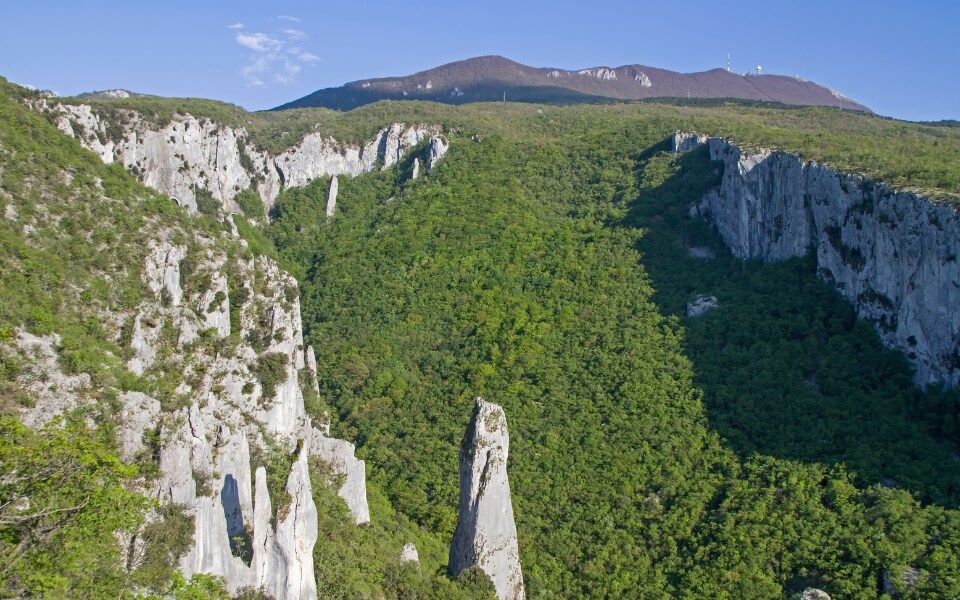 Vela Draga Canyon
Vela Draga Canyon
Vela Draga Canyon Educational Trail
Distance: 6.5 kilometres | Duration: 3-4 hours | Difficulty: Moderate Geological Focus: Limestone tower formations and canyon ecosystems
The Vela Draga Canyon trail showcases Istria’s dramatic karst landscape while providing access to ecosystems found nowhere else on the peninsula. The canyon’s limestone towers, rising 100 metres from the valley floor, create microclimates supporting relict plant species surviving from the last ice age.
Unique Canyon Ecosystem Features:
- Limestone Towers: Home to endemic rock-dwelling plants adapted to extreme conditions
- Canyon Floor Springs: Supporting amphibian populations including the rare Istrian Newt
- Cliff Face Vegetation: Specialised plant communities adapted to vertical limestone habitats
- Thermal Inversions: Creating frost pockets supporting boreal plant species at low elevations
Seasonal Nature Experiences: Maximising Wildlife Encounters
Spring Awakening: March-May
March: Early Wildflower Spectacle Spring arrives early in coastal Istria, with wildflower displays beginning in March when inland mountains may still experience snow. This creates exceptional opportunities for nature lovers to experience multiple seasons simultaneously within short EV journeys.
Coastal Wildflower Calendar:
- March: Cyclamen coum, Anemone blanda, Crocus chrysanthus
- April: Fritillaria meleagris, Orchis morio, Iris germanica
- May: Ophrys apifera, Paeonia mascula, Dictamnus albus
Prime Wildlife Viewing: Spring migration brings exceptional birdwatching opportunities. The Lim Fjord serves as a crucial stopover for migrating raptors, with Honey Buzzards, Short-toed Eagles, and Lesser Spotted Eagles passing through in March-April. Early morning EV journeys to coastal observation points yield spectacular results.
April-May: Truffle Season Transition The overlap between white truffle season (ending in January) and black truffle season (peaking April-August) creates unique opportunities for nature lovers to understand forest floor ecosystems. Truffle hunting tours during this period focus on ecological education rather than harvest, making them ideal for environmentally conscious travellers.
Summer Abundance: June-August
Peak Biodiversity Period Summer represents Istria’s peak biodiversity season, with all endemic species in full display and mountain hiking conditions at their optimal. However, EV drivers must plan for increased energy consumption due to climate control needs during hot afternoons.
Mountain Escape Strategy: Utilise EV efficiency advantages by planning uphill journeys during cool morning hours (6-9 AM) and return descents during afternoon heat when regenerative braking provides natural air conditioning and energy recovery.
Endemic Summer Blooms:
- June: Iris pseudopallida (Istrian Iris) - Endemic to Učka limestone
- July: Campanula istriaca (Učka Bellflower) - Found only above 800m elevation
- August: Gentiana lutea (Great Yellow Gentian) - Rare Balkan endemic
Night-time Nature Experiences: Summer’s long daylight hours (15+ hours in June) allow for unique nocturnal wildlife observation. Glow-worm displays in Motovun Forest peak in July, while Barn Owls and Tawny Owls become active around dusk in mountain valleys.
Autumn Glory: September-November
Peak Truffle Season and Forest Colours Autumn represents Istria’s premier nature season, combining peak truffle hunting opportunities with spectacular deciduous forest displays. The convergence of harvest season, wildlife preparation for winter, and optimal hiking weather creates ideal conditions for serious nature enthusiasts.
September-November Truffle Ecology: White truffle season (Tuber magnatum) peaks September-January, while black truffle (Tuber melanosporum) reaches optimal maturity October-February. This overlap creates exceptional opportunities to understand mycorrhizal forest ecosystems through hands-on truffle hunting experiences.
Professional Truffle Hunting Tours for Nature Lovers:
- Karlić Tartufi (Paladini village): Multi-generational family operation since 1966
- Miro Tartufi (Motovun): Ecological education focus with forest conservation insights
- Zigante Tartufi (Livade): Commercial operation offering ecosystem interpretation
Autumn Wildlife Activity:
- Red Deer Rutting Season: October brings dramatic calling echoes through Učka valleys
- Bird Migration Peak: September-October migration offers exceptional raptor viewing
- Brown Bear Activity: Autumn foraging brings occasional bear sightings in remote Učka areas
- Mushroom Season: Beyond truffles, forests explode with diverse fungi species
Forest Photography Conditions: October-November provides optimal lighting for forest photography, with deciduous canopy creating dappled sunlight perfect for wildlife photography. Učka’s beech forests reach peak colour mid-October, while oak woodlands maintain colour through November.
EV-Specific Considerations for Istrian Mountain Terrain
Hill Climbing and Range Management
Elevation Profiles and Energy Consumption Istria’s mountainous interior presents EV drivers with significant elevation changes requiring careful energy management. The coastal plain to Učka summit represents a 1,401-metre elevation gain over 60 kilometres, reducing typical EV range by 20-30% on ascent while providing substantial energy recovery during descent.
Route-Specific Range Calculations:
- Pula to Vojak Summit: 85km distance + 1,401m elevation = 35-40% battery consumption
- Rovinj to Motovun: 45km distance + 277m elevation = 12-15% battery consumption
- Motovun to Buzet: 30km distance + 150m elevation = 8-10% battery consumption
Regenerative Braking Optimisation: Učka’s winding descent roads provide exceptional energy recovery opportunities. Experienced EV drivers report 15-25% range recovery during controlled descents from Vojak to coastal charging stations, making mountain exploration surprisingly energy-neutral.
Cold Weather Efficiency: Mountain temperatures drop 6-7°C per 1,000 metres elevation, requiring battery pre-conditioning for optimal performance. Winter visits to Učka (December-February) should plan for 25-35% range reduction due to both elevation and temperature effects.
Strategic Charging Planning for Nature Destinations
Primary Charging Hubs with Nature Access:
- Pula ELEN Station (350kW): Gateway to Brijuni National Park and coastal ecosystems
- Rovinj Marina Complex (150kW): Access to Lim Fjord and coastal forest trails
- Buzet City Centre (100kW): Motovun Forest and truffle hunting base
- Poklon Mountain Hut (22kW): Učka Nature Park summit access point
Destination Charging Opportunities: Many nature-focused accommodations now offer Tesla Destination Chargers or 22kW Type 2 charging included in nightly rates. Eco-conscious hotels in Motovun, Grožnjan, and Buje specifically cater to sustainable travellers with guaranteed EV charging access.
Emergency Charging Protocol: Mobile coverage throughout Istria enables reliable communication with HAK (Croatian Automobile Club) roadside assistance. The organisation maintains EV-specific support vehicles capable of providing emergency charging to reach nearest infrastructure.
Wildlife Conservation and Sustainable Tourism
Responsible Nature Observation Practices
Minimal Impact Guidelines for EV Nature Tourism Electric vehicle travel inherently supports conservation goals, but nature lovers can further minimise environmental impact through conscious behaviour choices during wildlife observation and habitat exploration.
Wildlife Observation Ethics:
- Maintain 50-metre distance from large mammals (bears, deer, wild boar)
- Use telephoto lenses rather than approaching wildlife for photography
- Avoid flash photography that can disturb nocturnal species
- Stay on marked trails to prevent trampling fragile alpine vegetation
- Pack out all waste including organic materials that disrupt natural nutrient cycles
Endemic Species Protection: Istria’s endemic plant species, particularly Campanula istriaca and Iris pseudopallida, exist in extremely limited populations. Photography is encouraged, but never collect specimens or disturb growing sites. Seed collection is prohibited throughout protected areas.
Supporting Local Conservation Efforts
Community-Based Conservation Projects Several Istrian communities operate conservation initiatives that welcome nature-loving visitors while supporting habitat protection. EV-driving nature enthusiasts can contribute to these efforts through participation fees and volunteer opportunities.
Učka Nature Park Volunteer Programs:
- Trail Maintenance Weekends: Monthly activities maintaining hiking infrastructure
- Endemic Species Monitoring: Citizen science projects tracking rare plant populations
- Wildlife Camera Surveys: Assisting researchers documenting brown bear and lynx movements
- Educational Programme Support: Guiding school groups through ecosystem interpretation
Truffle Forest Conservation: Traditional truffle hunting families practice sustainable harvesting that supports forest health. Participating in educational truffle tours contributes to forest conservation while learning about mycorrhizal ecosystem functions.
Accommodation: Nature-Focused EV-Friendly Options
Eco-Conscious Mountain Retreats
Hotel Kempinski Adriatic (Savudrija)
- EV Facilities: Tesla Supercharger + Universal 22kW charging stations
- Nature Access: Direct access to Savudrija Nature Reserve coastal wetlands
- Conservation Focus: Active seagrass meadow restoration project
- Pricing: €280-420/night (peak season)
Villa Dama (Motovun)
- EV Facilities: 22kW Type 2 charging included in room rate
- Location: 2km from Motovun Forest truffle hunting areas
- Sustainability: Solar-powered, locally sourced organic breakfast
- Pricing: €150-220/night
Mountain Huts and Eco-Lodges
Poklon Mountain Hut (Učka Nature Park)
- EV Facilities: 22kW AC charging station
- Nature Immersion: Located at 1,000m elevation within Učka Nature Park
- Activities: Guided night-time wildlife observation, alpine flora workshops
- Pricing: €60-85/night (dormitory), €120-150/night (private rooms)
Accommodation Booking Strategy: Reserve EV-equipped accommodation well in advance, particularly during truffle season (September-November) and peak hiking months (May-September). Many properties offer package deals combining accommodation, EV charging, and guided nature activities.
Culinary Ecology: Sustainable Gastronomy Experiences
Truffle Gastronomy and Forest Ecosystem Understanding
Truffle-Focused Restaurants with Educational Components Istrian truffle restaurants increasingly emphasise ecological education alongside culinary excellence, helping nature lovers understand forest ecosystem functions through gastronomic experiences.
Restaurant Zigante (Livade)
- Michelin Recognition: Bib Gourmand status for exceptional truffle cuisine
- Educational Focus: Seasonal menus explaining truffle life cycles and forest health
- EV Access: 22kW charging station in restaurant car park
- Signature Experience: 7-course tasting menu featuring both black and white truffles
Konoba Mondo (Motovun)
- Farm-to-Table Focus: Ingredients sourced within 15km radius
- Truffle Education: Interactive presentations on mycorrhizal relationships
- Local Wine Pairing: Organic Istrian wines supporting biodiversity-friendly viticulture
- Pricing: €85-120 per person for truffle tasting menu
Seasonal Wild Food Experiences
Spring Wild Greens Tours (March-May) Several Istrian operators offer wild food foraging tours combining EV-accessible locations with education about edible native plants. These experiences teach sustainable harvesting while supporting understanding of Mediterranean ecosystem food webs.
Wild Species Commonly Featured:
- Wild Asparagus (Asparagus acutifolius): Abundant in coastal scrubland
- Dandelion Greens (Taraxacum officinale): Traditional spring detox vegetable
- Nettle (Urtica dioica): Early spring superfood rich in minerals
- Wild Fennel (Foeniculum vulgare): Coastal endemic used throughout Istrian cuisine
Autumn Mushroom Season (September-November) Beyond truffle hunting, Istrian forests produce dozens of edible mushroom species. Guided mushroom tours teach identification skills while explaining fungal ecosystem roles and sustainable harvesting practices.
Practical EV Travel Tips for Nature Enthusiasts
Essential Apps and Navigation Tools
easyCharging App: Your Complete Croatian Solution The easyCharging app provides comprehensive access to Croatia’s expanding EV network, including real-time availability at nature destinations throughout Istria. Key benefits for nature lovers include:
Real-Time Nature Destination Charging: Check charging availability at Učka Nature Park, Brijuni National Park, and remote trailheads before departing, ensuring access during peak hiking seasons.
Transparent Cost Planning: View exact charging costs (typically €0.35-€0.45/kWh in Croatia) for accurate budget planning during extended nature excursions.
24/7 Support: Access technical support when experiencing charging difficulties in remote locations.
Croatia-Specific Nature Apps:
- Croatia National Parks: Official app with trail maps and wildlife information
- iNaturalist: Citizen science platform for documenting endemic species observations
- PeakVisor: Mountain identification and hiking trail planning
- Windy: Detailed weather forecasting crucial for mountain hiking safety
Safety Considerations for Mountain EV Travel
Mountain Weather Awareness Istrian mountain weather changes rapidly, particularly on Učka where Mediterranean and Continental air masses collide. EV drivers should monitor conditions carefully as heating and cooling needs significantly impact range calculations.
Emergency Preparedness Checklist:
- Portable EV charger (Type 2 to domestic socket adapter) for emergency situations
- Weather protection gear suitable for sudden temperature changes
- First aid kit with supplies for hiking-related injuries
- Emergency contact numbers including HAK roadside assistance (987) and Mountain Rescue (112)
- Offline maps downloaded to multiple devices for areas with poor mobile coverage
Wildlife Safety Protocol: While dangerous wildlife encounters remain extremely rare, nature lovers should understand appropriate responses to potential brown bear or wild boar encounters in remote Učka areas.
Bear Safety Guidelines:
- Make noise while hiking to avoid surprising bears
- Travel in groups particularly in dense forest areas
- Carry bear spray (available at outdoor shops in Buzet and Motovun)
- Store food securely in vehicles or designated containers
- Report bear sightings to park authorities for monitoring purposes
Budget Planning: Complete Cost Analysis for Nature Lovers
Daily EV Charging Costs for Nature Routes
Typical Daily Charging Expenses:
- Coastal exploration (Pula-Rovinj-Poreč): €8-12 (150-200km range)
- Mountain hiking (Učka summit routes): €10-15 (elevation gains increase consumption)
- Truffle forest tours (Motovun region): €6-10 (shorter distances, moderate terrain)
- Mixed ecosystem tours (coast to mountains): €12-18 (full day comprehensive routes)
Money-Saving EV Strategies:
- Utilise Hotel Charging: Many nature-focused accommodations include EV charging in room rates
- Plan Descents Strategically: Schedule mountain descents during hot afternoons to maximise regenerative braking and natural cooling
- Off-Peak Charging: Some Croatian networks offer 20-30% discounts during night hours (22:00-06:00)
- Membership Benefits: easyCharging subscriptions provide savings for extended nature touring
Activity and Experience Pricing
Nature-Based Activity Costs:
- Truffle hunting tours: €85-120 per person (including tasting)
- Učka Nature Park guided hikes: €45-65 per person (full day)
- Brijuni National Park entry: €200-250 (family tickets including boat transport)
- Wildlife photography workshops: €120-180 per person (expert guidance)
- Wild food foraging tours: €55-75 per person (half day)
Annual Park Passes: Croatian National Parks Annual Pass (€50-70) provides excellent value for nature enthusiasts planning multiple visits across Croatia’s protected areas.
Accommodation Budget Ranges
Nature-Focused Accommodation Tiers:
Budget-Conscious Options (€40-80/night):
- Mountain huts with basic EV charging
- Eco-camping with electrical hookups
- Rural agritourism with sustainability focus
Mid-Range Comfort (€80-180/night):
- Boutique nature hotels with destination charging
- Converted stone villas in hilltop villages
- Eco-resorts with comprehensive EV facilities
Premium Nature Experiences (€180-400/night):
- Luxury eco-lodges with private nature access
- Historic castles converted to sustainable hotels
- Wellness retreats with forest therapy programmes
Advanced Nature Experiences for Serious Enthusiasts
Multi-Day Ecosystem Immersion
5-Day Complete Istrian Ecosystem Tour
Day 1: Coastal Marine Ecosystems
- Morning: Brijuni National Park marine sanctuary exploration
- Afternoon: Fažana wetland bird observation
- Evening: Pula coastal cliff ecosystem study
- Charging Strategy: Fažana ferry terminal (4 hours) + Pula ELEN overnight
Day 2: Transition Zone Exploration
- Morning: Lim Fjord estuary ecosystem kayaking
- Afternoon: Rovinj archipelago botanical survey
- Evening: Grožnjan hilltop village transition zones
- Charging Strategy: Rovinj Marina rapid charging during lunch
Day 3: Truffle Forest Deep Dive
- Full Day: Motovun Forest comprehensive ecological study
- Activities: Truffle hunting, mycological survey, wildlife tracking
- Educational Focus: Mycorrhizal network understanding
- Charging Strategy: Motovun village slow charging during activities
Day 4: Mountain Alpine Ecosystems
- Morning: Učka Nature Park alpine zone ascent
- Afternoon: Vojak summit endemic species documentation
- Evening: Poklon mountain meadow observation
- Charging Strategy: Poklon Mountain Hut overnight charging
Day 5: Karst Landscape Systems
- Morning: Vela Draga Canyon geological ecosystem study
- Afternoon: Pazin Cave underground ecosystem exploration
- Conclusion: Ecosystem connectivity understanding
- Charging Strategy: Pazin town centre before departure
Citizen Science Participation Opportunities
Endemic Species Monitoring Projects Several Croatian research institutions welcome trained volunteers to assist with endemic species monitoring throughout Istria. EV-driving nature enthusiasts can contribute valuable data while learning from professional researchers.
Učka Bellflower Monitoring Program:
- Season: June-August flowering period
- Commitment: 2-3 day visits across season
- Training: Provided by University of Zagreb botany department
- Contribution: Population mapping and health assessment
Brown Bear Movement Tracking:
- Technology: Trail camera maintenance and data collection
- Areas: Remote Učka locations accessible by EV to trail parking
- Commitment: Monthly monitoring visits
- Research Partner: Croatian Forest Research Institute
Regional Driving Considerations: Optimising EV Performance
Karst Terrain and Vehicle Efficiency
Limestone Landscape Challenges Istria’s limestone karst topography creates unique driving conditions affecting EV efficiency. The combination of moderate gradients, frequent elevation changes, and limestone road surfaces requires adjusted driving strategies for optimal range management.
Karst-Specific EV Techniques:
- Anticipatory Driving: Karst valleys and hills create frequent elevation changes requiring smooth acceleration and braking transitions
- Surface Adaptation: Limestone dust can reduce tire traction; maintain appropriate following distances particularly in dry conditions
- Route Selection: Choose newer asphalt roads over older limestone chip surfaces for improved efficiency
Seasonal Road Conditions:
- Spring (March-May): Occasional rockfall on mountain roads; check HAK road conditions before departing
- Summer (June-August): Limestone surfaces retain heat; plan mountain ascents during cooler morning hours
- Autumn (September-November): Falling leaves can obscure road markings on forest routes
- Winter (December-February): Elevation above 800m may require winter tires; check Učka access conditions
Wind Patterns and Coastal Driving
Bura Wind Management The Bura (strong northeastern wind) significantly impacts EV efficiency along Istria’s eastern coast, particularly near Rijeka and the Učka mountain base. This cold, dry wind can create headwinds exceeding 100 km/h, substantially increasing energy consumption.
Bura Season Strategy:
- Peak Season: November-March with occasional summer episodes
- Route Adaptation: Use inland routes via Buzet and Motovun when coastal Bura warnings active
- Weather Monitoring: Check Windy.com for detailed wind forecasts before coastal nature excursions
- Energy Management: Plan 15-25% additional range when driving into strong Bura conditions
Cultural Integration: Nature and Heritage Harmony
Medieval Hilltop Towns as Ecosystem Observation Points
Motovun: Truffle Capital and Wildlife Observatory The medieval town of Motovun, perched 277 metres above the Mirna River Valley, serves dual purposes as cultural heritage site and exceptional wildlife observation platform. The town’s elevated position provides unobstructed views across the Motovun Forest—perfect for dawn and dusk wildlife spotting.
Dawn Wildlife Observation Opportunities:
- 5:30-7:00 AM: Wild boar foraging visible in forest clearings
- 6:00-8:00 AM: Red deer movement along forest edges
- 7:00-9:00 AM: Raptor activity as thermals develop
Cultural-Natural Heritage Integration: Motovun’s medieval walls incorporate local limestone containing fossilised marine organisms from when Istria lay beneath the Tethys Sea. Nature lovers can observe geological time scales while planning forest expeditions.
Grožnjan: Artist Colony and Bird Migration Hub Grožnjan, known as Istria’s “Town of Artists,” occupies a strategic position on migration routes used by raptors crossing the Adriatic. The town’s hilltop position and artist community create unique opportunities for nature-focused cultural experiences.
Migration Season Highlights:
- September: Honey Buzzards pass through in spectacular concentrations
- October: Short-toed Eagles and Lesser Spotted Eagles peak migration
- November: Common Buzzards and Rough-legged Buzzards winter arrivals
Traditional Ecological Knowledge
Istrian Farming and Biodiversity Conservation Traditional Istrian agricultural practices, maintained across centuries, created the mosaic landscapes supporting today’s exceptional biodiversity. Olive groves, vineyards, and mixed pastures serve as wildlife corridors connecting forest patches and maintaining genetic diversity among plant and animal populations.
Traditional Practices Supporting Wildlife:
- Stone Wall Construction: Limestone field boundaries provide habitat for reptiles and small mammals
- Mixed Agriculture: Diverse crops support varied insect populations crucial for bird and bat species
- Transhumance Grazing: Seasonal livestock movement maintains alpine meadow plant diversity
- Forest Management: Selective harvesting maintains diverse age classes supporting numerous species
Learning Opportunities: Several Istrian agritourism operations offer workshops teaching traditional practices from ecological perspectives. These experiences help nature lovers understand how human activities can support rather than threaten biodiversity.
Conclusion: Your Sustainable Nature Adventure Awaits
Croatia’s Istrian Peninsula represents Europe’s premier destination for nature lovers seeking comprehensive ecosystem exploration through sustainable electric vehicle travel. From the pristine marine sanctuaries of Brijuni National Park to the endemic alpine flora of Učka’s summit meadows, this biodiverse region offers unparalleled natural experiences within a compact, EV-friendly area.
The transformation of Croatia’s charging infrastructure, with reliable stations now available every 60 kilometres and growing, has eliminated range anxiety while opening access to some of Europe’s most pristine wilderness areas. The easyCharging app provides seamless access to this expanding network, ensuring nature enthusiasts can focus on wildlife observation and ecosystem exploration rather than charging logistics.
Istria’s unique position where Mediterranean and Central European ecosystems converge creates biodiversity concentrations rivalling much larger protected areas. The opportunity to observe brown bears, lynx, and golden eagles alongside endemic plant species found nowhere else on Earth—all within comfortable EV range of excellent charging infrastructure—makes this region exceptional among European nature destinations.
The integration of truffle hunting, alpine hiking, marine ecosystem exploration, and cultural heritage creates a complete nature experience that satisfies both ecological curiosity and adventure seeking. The region’s commitment to sustainable tourism and conservation ensures that responsible nature lovers contribute to habitat protection while gaining unprecedented access to wilderness experiences.
Ready to Begin Your Istrian Nature Adventure? Download the easyCharging app today and start planning your comprehensive ecosystem exploration. With transparent pricing, real-time availability, and comprehensive coverage across Croatia’s nature destinations, your sustainable adventure through one of Europe’s most biodiverse regions begins with a single app download.
The heart-shaped peninsula of Istria awaits your discovery—combining cutting-edge sustainable travel infrastructure with pristine wilderness experiences that will redefine your understanding of European nature tourism. Your electric vehicle journey through this ecological treasure will create memories lasting a lifetime while pioneering the future of responsible nature exploration.
Frequently asked questions
Yes, Croatia has invested €200 million in EV infrastructure with charging stations every 60km on major routes by 2025. Učka Nature Park now has 22kW charging at Poklon Mountain Hut, while Pula and Rovinj offer ultra-fast 350kW charging.
Ascending from sea level to Vojak peak (1,401m) typically reduces range by 20-30% due to elevation gain. However, regenerative braking on descent recovers 15-25% of energy used. Plan for 35-40% total battery consumption for the complete Pula-to-Vojak round trip, including exploration time.
Croatia’s HAK roadside assistance (call 987) operates EV-specific support vehicles throughout Istria. Mobile coverage is excellent in nature areas, and most truffle hunting locations are within 15km of charging infrastructure. Carry a Type 2 to domestic socket adapter for emergency charging at rural accommodations.
All major Istrian nature destinations are EV-accessible via paved roads. Učka’s summit road is well-maintained year-round, though winter conditions above 800m may require winter tyres. The most remote areas like Vela Draga Canyon have parking within 2km of trailheads, making them perfectly suitable for all EV models.
Spring (March-May) and autumn (September-November) offer optimal conditions with minimal heating/cooling needs. Summer heat can reduce efficiency by 10-15%, while winter mountain visits may decrease range by 25-35%. Peak truffle season (September-November) coincides with excellent EV performance conditions.
Peak season (September-November) can create waiting times at popular locations like Motovun. Use the easyCharging app to check real-time availability and plan alternative routes via Buzet or Grožnjan charging points. Most truffle tours last 2-3 hours, providing natural charging windows.
Yes, all major nature destinations are accessible via well-maintained paved roads suitable for standard passenger EVs. Učka summit road, Motovun approaches, and national park access routes are designed for regular tourism traffic. Ground clearance requirements are no different from typical European mountain driving.

